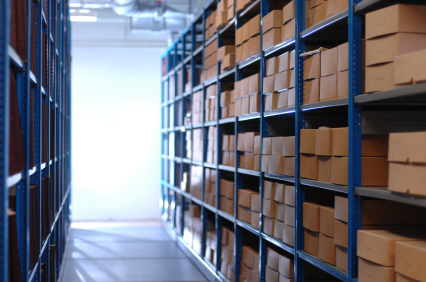Self storage shelving

Vertical space
Self storage units are sold by the square foot ‒ i.e. the ground plan. And it is all too easy to visualise the space in terms of the floor. The floor is the first area to get filled, and ‒ without proper planning ‒ that may be all that gets filled.
But most self storage units are at least 8‒10 ft tall. To get value-for-money, you need think how best to fill that three-dimensional space.
Traditional wisdom says: Put the heavy, sturdy things at the bottom, then stack lighter things on top: hat-boxes on top of boxes filled with books, on top of a chest of drawers.
Shelf life
It depends what you want to store, of course, but shelving could make the most efficient use of the space. Not so good for furniture, white goods, and bicycles, or even really heavy boxes filled with books or vinyl records (except on the bottom shelf) ‒ but excellent for lighter boxes filled with ornaments, kitchenware, bed linen, shoes, cushions and toys, or loose, hard-to-pack items such as lampshades or sporting equipment (ski boots, cricket pads, boogie boards).
If you fill the shelves well all the way the ceiling, this will give you optimum use of the vertical space, and it will give you easy access to your possessions. So if you want to get to a book in a box sensibly stored on the floor, you won’t have to pick off every box stacked on top it to reach it. List the contents of every box on its outward-facing side, and your unit will be the model of efficiency.
You can have shelving against every wall of the unit, and even shelving in a central island, if there is enough room for a passageway all the way round. But shelving can be very useful in just part of the unit, especially if you are storing a mixture of furniture and shelve-able items.
Worth the investment?
Well, that is something you will have to judge for yourself, but shelving need not be expensive.
It does, however, have to be free-standing, as you cannot (usually) screw any fixture to the walls or ceiling in a self storage unit.
IKEA has a good range of strong, wooden shelving, notably in the IVAR series, designed for cellars and garages as well as living rooms, with plenty of flexibility in the heights you can set the shelving at. These come flat-packed, and require quite a bit of time to erect (you may be best advised to equip yourself with an electric drill with a bolt-tightening attachment). Typically a unit with four shelves, 90cm wide, will cost under £40.
Another supplier is Big Dug, “the UK’s No.1 for low cost shelving”, who produce metal and wooden industrial shelving of varying sizes from as little as £30.
So you may be spending between £30 and perhaps £300 to erect shelving in your storage unit, depending on the amount you install. Is it worth it?
You can think of it in two ways. First, an investment of £30–£300 may be relatively small when set against the total cost of renting a storage unit (which could be £1800 per annum for 100 sq ft) – especially if you are planning long-term occupation.
Second, if you are getting better use of vertical space, you may actually be able to rent a smaller unit, so there would savings that you could put against your outlay for the shelving.
Leave a Reply
Subscribe to This Blog
Get new blog posts sent to you by subscribing to RSS updates or to email updates.






